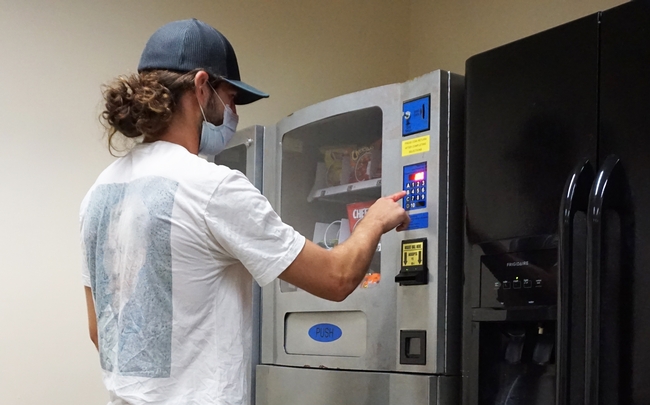Healthy vending grows in popularity on UC campuses
Raw hunger or thirst usually draws people to buy snacks from vending machines. Healthy options, calorie counts and reminders help consumers make good-sense decisions when they slip in coins or a credit card, according to research by a working group organized under UC's Global Food Initiative and led by the UC Nutrition Policy Institute.
The working group set out to develop guidelines for food service providers at all 10 UC campuses and other UC facilities in stocking and promoting healthy options in their vending machines. They also created a toolkit with step-by-step guidance in making the switch, including everything from early meetings with students, food service and vendors to anticipating and preparing for barriers to implementation.
As part of the project, the Nutrition Policy Institute evaluated data from six UC campuses that show healthy vending options are growing in popularity, which eases concerns about a potential reduction in profit by making vending healthier.
“In 2005, California began introducing policies limiting junk food in vending machines and student stores on K-12 campuses,” said Janice Kao, a researcher at the Nutrition Policy Institute and chair of the working group. “Today's college students are used to having healthy snack options in schools. Customer resistance that some vendors talk about isn't necessarily the case anymore.”
Two UC campuses – UCLA and UC San Francisco – have been early adopters in making healthy vending machine choices available. According to the evaluation, the two locations achieved the goal of having 70% of their beverage vending products fit the “healthy” description. Other UC campuses are working on adding healthy options – with a wide variation in implementation and definition of “healthy.”
The Global Food Initiative working group recommends a higher standard for “healthy” snacks than some campuses and vendors. The key difference is the decision that an item can only be considered “healthy” if the first ingredient is a fruit, vegetable, low-fat dairy, protein or whole grain.
“This guideline means some granola bars cannot be considered a healthy snack,” Kao said.
Even so, the evaluation results showed improvement in the sales of healthy products.
“Campuses that have actively worked on healthy vending saw greater sales of healthy snacks and drinks,” Kao said. “We want to learn from those experiences and develop systemwide standards to provide consistency. With everyone following the same guidelines, there is potential to take advantage of systemwide food procurement economies of scale and contribute to meeting UC's sustainability goals.”
The NPI evaluation compared the greenhouse gas emissions associated with traditional vending and healthy vending. A dramatic difference emerged when comparing candy bar ingredients and healthy snack bar ingredients. Greenhouse gas emissions of candy bar ingredients were estimated to be more than twice as high as healthy snack bar ingredients.


Posted by Max Jones on May 26, 2021 at 9:24 AM